Our flag is often known as "Old Glory", here is why:
"I am the flag of the United States of America. My name is Old Glory. I fly atop the world's tallest buildings. I stand watch in America's halls of justice. I stand guard majestically over great institutions of learning.
I stand guard with the greatest military power in the world. Look up and see me. I stand for peace, honor, truth and justice. I stand for freedom. I am confident; I am arrogant; I am proud. When I am flown with my fellow banners, my head is a little higher, my colors a little truer. I bow to no one. I am recognized all over the world.
I am worshipped. I am loved and I am feared. I have fought in every battle of every war for more than 250 years: Gettysburg, Shilo, Appomattox, San Juan Hill, the trenches of France, the Argonne Forest, Anzio, Rome, the beaches of Normandy, Guam, Okinawa, Japan, Korea, Vietnam, in the Persian Gulf and a score of places long forgotten, by all but those who were there with me. I was there.
I led my Soldiers, Sailors, Airmen and Marines. I followed them and watched over them. They loved me. I was on a small hill on Iwo Jima. I was dirty, battle-worn and tired, but my Marines and Sailors cheered me. And I was proud.
I have been soiled, burned, torn and trampled on the streets of countries that I have helped set free. It does not hurt, for I have been soiled, burned, torn and trampled on the streets of my own country, and when it is by those I have served in battle with, it hurts. But I shall overcome, for I am strong. I have slipped the bonds of earth and from my vantage point on the moon, I stand watch over the uncharted new frontiers of space.
I have been silent witness to all of America's finest hours. But my finest hour comes when I am torn in strips to be used as bandages for my wounded comrades on the field of battle - when I fly at half mast to honor my Soldiers, my Airman, my Sailors, my Marines, and when I lie in the trembling arms of a grieving mother, at the graveside of her fallen son or daughter.
I am proud. My name is "Old Glory." Long may I wave, dear God, long may I wave."
Our beloved flag began with 13 stars and stripes, representing the original 13 colonies/states.
These were, in order of ratification of the Constitution:
| State | Date |
|---|---|
| Delaware | December 7th, 1787 |
| Pennsylvania | December 12th, 1787 |
| New Jersey | December 18th, 1787 |
| Georgia | January 2nd, 1788 |
| Connecticut | January 9th, 1788 |
| Massachusetts | February 6th, 1788 |
| Maryland | April 28th, 1788 |
| South Carolina | May 23rd, 1788 |
| New Hampshire * | June 21st, 1788 |
| Virginia | June 25th, 1788 |
| New York | July 26th, 1788 |
| North Carolina | November 21st, 1789 |
| Rhode Island | May 29th, 1790 |
The asterisk (*) indicates the two thirds needed and the Constitution is adopted at this point.
The Mysterious Origins of the American Flag
Originally, the intent was to add one star and one stripe for each state admitted, but with the admission of Vermont (1791), Kentucky (1792), Tennessee (1796), Ohio (1803), Louisiana (1812), Indiana (1816) and Mississippi (1817) it became obvious this was untenable, so the flag design was altered to fix the number of stripes at 13, while still adding a star for each new state. The principal acts affecting the flag of the United States are the following:
Act of June 14th, 1777, in order to establish an official flag for the new nation, the Continental Congress passed the first Flag Act: "Resolved, That the flag of the United States be made of thirteen stripes, alternate red and white; that the union be thirteen stars, white in a blue field, representing a new Constellation."
Act of January 13th, 1794 - provided for 15 stripes and 15 stars after May 1795.
Act of April 4th, 1818 - provided for 13 stripes and one star for each state, to be added to the flag on the 4th of July following the admission of each new state, signed by President Monroe.
Executive Order 1556, signed by President Taft, dated June 24th, 1912 - established proportions of the flag and provided for arrangement of the stars in six horizontal rows of eight each, a single point of each star to be upward. Prior ot this time, neither the order of the stars nor the proportions of the flag was prescribed. Consequently, flags dating before this period sometimes show unusual arrangements of the stars and odd proportions, these features being left to the discretion of the flag maker. In general, however, straight rows of stars and proportions similar to those later adopted officially were used.
Executive Order 1637, signed by President Taft, dated October 29th, 1912 - established more precise proportions for the flag, the stripes, the union and the stars.
Executive Order 2390, signed by President Wilson, dated May 29th, 1916 - established not only exact proportions but prescribed 12 standard sizes for the flag.
Executive Order of President Eisenhower, dated January 3rd, 1959 - provided for the arrangement of the stars in seven rows of seven stars each, staggered horizontally and vertically.
Executive Order of President Eisenhower, dated August 21st, 1959 - provided for the arrangement of the stars in nine rows of stars staggered horizontally and eleven rows of stars staggered vertically.
We are all proud of the U.S. flag (well except for a few malcontents, most with obscene salaries), but it has changed many times over the years, as states were added to the union.
Below are images of the various versions along with the states whose admission caused the change and the year (or years) that design was official.
If you wish to know the rules for display and handling of the flag, please read the Official U. S. Flag Code here.

The original 13 star flag, 1777 to 1795.
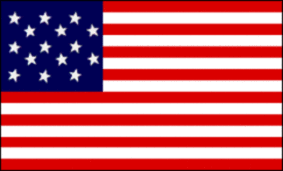
The 15 star (and stripe) flag (Vermont and Kentucky - the only time other than 13 stripes were used), 1795 to 1818. This is the flag Andrew Jackson fought under at the Battle of New Orleans.
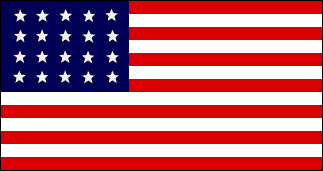
The 20 star flag (Tennessee, Ohio, Louisiana, Indiana, Mississippi), 1818 to 1819. The admission of these five states prompted the change to fix the number of stripes at 13.
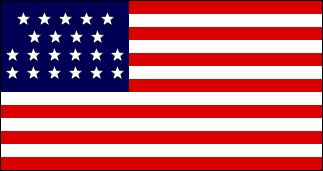
The 21 star flag (Illinois), 1819 to 1820.
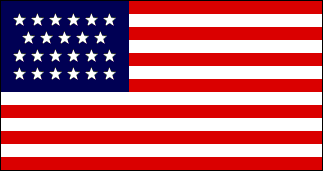
The 23 star flag (Alabama, Maine), 1820 to 1822.
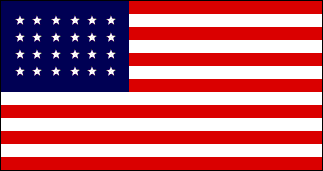
The 24 star flag (Missouri), 1822 to 1836.

The 25 star flag (Arkansas), 1836 to 1837.
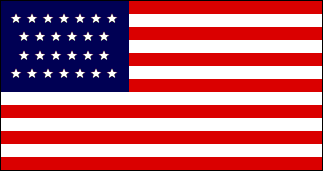
The 26 star flag (Michigan), 1837 to 1845.

The 27 star flag (Florida), 1845 to 1846.

The 28 star flag (Texas), 1846 to 1847.
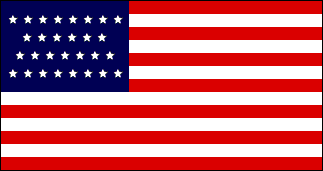
The 29 star flag (Iowa), 1847 to 1848.

The 30 star flag (Wisconsin), 1848 to 1851.
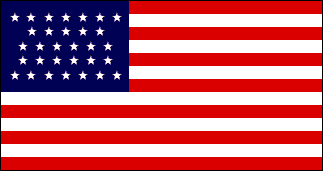
The 31 star flag (California), 1851 to 1858.
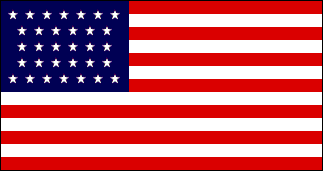
The 32 star flag (Minnesota), 1858 to 1859.
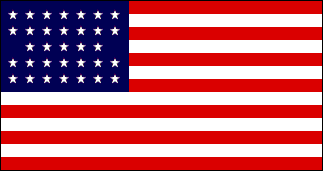
The 33 star flag (Oregon), 1859 to 1861.
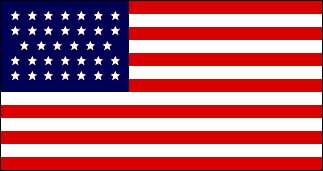
The 34 star flag (Kansas), 1861 to 1863.

The 35 star flag (West Virginia), 1863 to 1865.
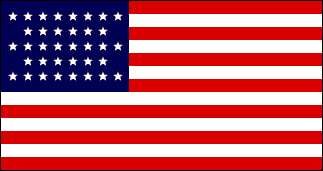
The 36 star flag (Nevada), 1865 to 1867.
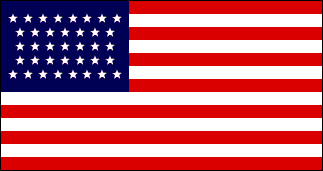
The 37 star flag (Nebraska), 1867 to 1877.
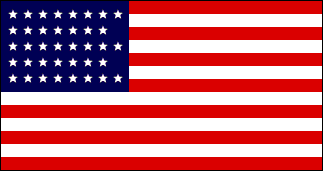
The 38 star flag (Colorado), 1877 to 1890.
NOTE: There was never an official 39 star flag, but some flag manufacturers believed that the two Dakotas would be admitted as one state and manufactured 39 star flags, a few of which still exist. It is also possible there are (or were) 40, 41, and 42 star flags produced by a few oddball manufacturers trying to second guess Congress, but no evidence of any such has surfaced.
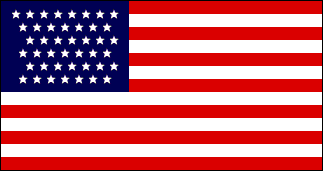
The 43 star flag (North Dakota, South Dakota, Montana, Washington, Idaho), 1890 to 1891.
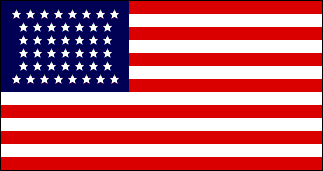
The 44 star flag (Wyoming), 1891 to 1896.

The 45 star flag (Utah), 1896 to 1908.
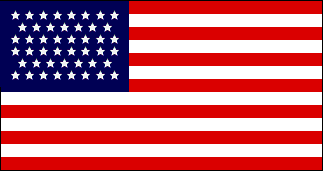
The 46 star flag (Oklahoma), 1908 to 1912.
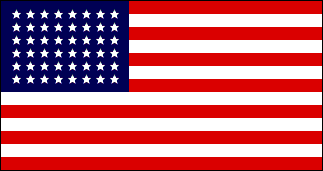
The 48 star flag I grew up under (New Mexico, Arizona), 1912 to 1959.
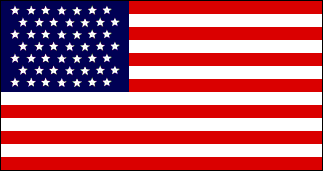
The 49 star flag (Alaska), 1959 to 1960.

The 50 star flag (Hawaii), 1960 to present.
In 2008 this became the longest serving design thus far and it appears it will survive for many more years, as there are no likely statehood candidates currently on the horizon. Well, that is until President Trump began his second term.
Shortly after President Dwight D. Eisenhower took office in 1953, his administration began to plan for the eventual admission of Alaska and Hawaii as the 49th and 50th states. One of the smaller details requiring attention was how adding two new white stars might alter the design of the existing United States flag. This challenge evidently captured the public’s imagination.
During the 1950s, more than 3,000 Americans mailed unsolicited designs for a 50-state flag to the White House, Congress and federal agencies. The submissions ranged from crayon sketches by schoolchildren to hand-sewn mock-ups. While they were certainly creative, many of these proposed flags did not follow the rules set by the 1818 law. You can view a few of those creative rejects on this page of the History Channel Website.
But, if (or when) Puerto Rico, Guam, the Virgin Islands or some other (as yet unknown) territory becomes a state, this 51 star flag may become a fact.
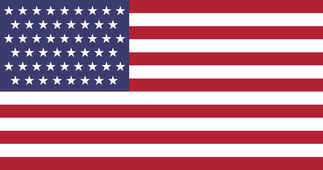
It is also possible that even more states will be admitted to the Union at some far future date. Below are some possible designs for 52, 53, 54 and 55 star flags as those states are admitted to the Union.
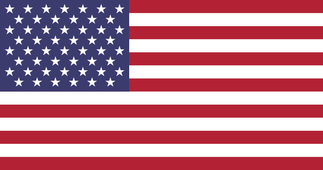
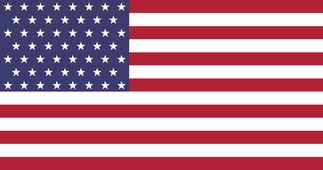

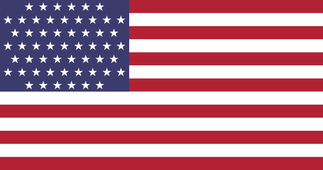
There exist mathematical methods of arranging most any number of stars for possible future flags. Up to 100 stars, only the 29, 69 and 87 star flags cannot be shoehorned into one of the more traditional and historical patterns seen in the previous flags (above).
Please see Possible Future Flag Arrangements.
Title 4, United States Code, Chapter 1
I suspect most of us have violated the flag code at one time or another, in particular § 8 (§ is the symbol for Section, in legal parlance), paragraphs c, d. g, i and j. Unintentionally, for most, though not all, as you are well aware.
While the Flag Code is U. S. Law, there are no penalties specified, except for those in § 3, and those only apply for offenses committed within the District of Columbia. So relax - you aren't likely to go to jail.
Title 4, United States Code, Chapter 1, is reproduced below. It can also be viewed at by clicking on the title, above. The Flag Code consists of § 4 through § 10.
The flag, itself, is defined in § 1 and § 2 of Title 4, United States Code, Chapter 1. § 3 prohibits use of the flag for advertising purposes or mutilation of the flag, and is the only part with a specified penalty (a fine not exceeding $100 or imprisonment for not more than thirty days, or both).
As Adopted by the National Flag Conference, Washington, D.C., June 14-15, 1923, and Revised and Endorsed by the Second National Flag Conference, Washington, D.C., May 15, 1924. Revised and adopted at P.L. 623, 77th Congress, Second Session, June 22, 1942; as Amended by P.L. 829, 77th Congress, Second Session, December 22, 1942; P.L. 107 83rd Congress, 1st Session, July 9, 1953; P.L. 396, 83rd Congress, Second Session, June 14, 1954; P.L. 363, 90th Congress, Second Session, June 28, 1968; P.L. 344, 94th Congress, Second Session, July 7, 1976; P.L. 322, 103rd Congress, Second Session, September 13, 1994; P.L. 225, 105th Congress, Second Session, August 12, 1998; and P.L. 80, 106th Congress, First Session, October 25, 1999.
§ 1. 1 - Flag; stripes and stars on
The flag of the United States shall be thirteen horizontal stripes, alternate red and white; and the union of the flag shall be forty-eight stars, white in a blue field.
§ 2. Same; additional stars
On the admission of a new State into the Union one star shall be added to the union of the flag; and such addition shall take effect on the fourth day of July then next succeeding such admission.
§ 3. Use of flag for advertising purposes; mutilation of flag
Any person who, within the District of Columbia, in any manner, for exhibition or display, shall place or cause to be placed any word, figure, mark, picture, design, drawing, or any advertisement of any nature upon any flag, standard, colors, or ensign of the United States of America; or shall expose or cause to be exposed to public view any such flag, standard, colors, or ensign upon which shall have been printed, painted, or otherwise placed, or to which shall be attached, appended, affixed, or annexed any word, figure, mark, picture, design, or drawing, or any advertisement of any nature; or who, within the District of Columbia, shall manufacture, sell, expose for sale, or to public view, or give away or have in possession for sale, or to be given away or for use for any purpose, any article or substance being an article of merchandise, or a receptacle for merchandise or article or thing for carrying or transporting merchandise, upon which shall have been printed, painted, attached, or otherwise placed a representation of any such flag, standard, colors, or ensign, to advertise, call attention to, decorate, mark, or distinguish the article or substance on which so placed shall be deemed guilty of a misdemeanor and shall be punished by a fine not exceeding $100 or by imprisonment for not more than thirty days, or both, in the discretion of the court. The words “flag, standard, colors, or ensign”, as used herein, shall include any flag, standard, colors, ensign, or any picture or representation of either, or of any part or parts of either, made of any substance or represented on any substance, of any size evidently purporting to be either of said flag, standard, colors, or ensign of the United States of America or a picture or a representation of either, upon which shall be shown the colors, the stars and the stripes, in any number of either thereof, or of any part or parts of either, by which the average person seeing the same without deliberation may believe the same to represent the flag, colors, standard, or ensign of the United States of America.
§ 4. Pledge of Allegiance to the flag; manner of delivery
The Pledge of Allegiance to the Flag, "I pledge allegiance to the Flag of the United States of America, and to the Republic for which it stands, one Nation under God, indivisible, with liberty and justice for all.", should be rendered by standing at attention facing the flag with the right hand over the heart. When not in uniform men should remove their headdress with their right hand and hold it at the left shoulder, the hand being over the heart. Persons in uniform should remain silent, face the flag, and render the military salute.
§ 5. Display and use of flag by civilians; codification of rules and customs; definition
The following codification of existing rules and customs pertaining to the display and use of the flag of the United States of America is established for the use of such civilians or civilian groups or organizations as may not be required to conform with regulations promulgated by one or more executive departments of the Government of the United States. The flag of the United States for the purpose of this chapter shall be defined according to sections 1 and 2 of this title and Executive Order 10834 issued pursuant thereto.
§ 6. Time and occasions for display
- It is the universal custom to display the flag only from sunrise to sunset on buildings and on stationary flagstaffs in the open. However, when a patriotic effect is desired, the flag may be displayed 24 hours a day if properly illuminated during the hours of darkness.
- The flag should be hoisted briskly and lowered ceremoniously.
- The flag should not be displayed on days when the weather is inclement, except when an all weather flag is displayed.
- The flag should be displayed on all days, especially on New Year's Day, January 1; Inauguration Day, January 20; Martin Luther King, Jr.'s birthday, the third Monday in January; Lincoln's Birthday, February 12; Washington's Birthday, third Monday in February; Easter Sunday (variable); Mother's Day, second Sunday in May; Armed Forces Day, third Saturday in May; Memorial Day (half-staff until noon), the last Monday in May; Flag Day, June 14; Independence Day, July 4; Labor Day, first Monday in September; Constitution Day, September 17; Columbus Day, second Monday in October; Navy Day, October 27; Veterans Day, November 11; Thanksgiving Day, fourth Thursday in November; Christmas Day, December 25; and such other days as may be proclaimed by the President of the United States; the birthdays of States (date of admission); and on State holidays.
- The flag should be displayed daily on or near the main administration building of every public institution.
- The flag should be displayed in or near every polling place on election -days.
- The flag should be displayed during school days in or near every schoolhouse.
§ 7. Position and manner of display
The flag, when carried in a procession with another flag or flags, should be either on the marching right; that is, the flag's own right, or, if there is a line of other flags, in front of the center of that line.
- The flag should not be displayed on a float in a parade except from a staff, or as provided in subsection (i) of this section.
- The flag should not be draped over the hood, top, sides, or back of a vehicle or of a railroad train or a boat. When the flag is displayed on a motorcar, the staff shall be fixed firmly to the chassis or clamped to the right fender.
- No other flag or pennant should be placed above or, if on the same level, to the right of the flag of the United States of America, except during church services conducted by naval chaplains at sea, when the church pennant may be flown above the flag during church services for the personnel of the Navy. No person shall display the flag of the United Nations or any other national or international flag equal, above, or in a position of superior prominence or honor to, or in place of, the flag of the United States at any place within the United States or any Territory or possession thereof: Provided, That nothing in this section shall make unlawful the continuance of the practice heretofore followed of displaying the flag of the United Nations in a position of superior prominence or honor, and other national flags in positions of equal prominence or honor, with that of the flag of the United States at the headquarters of the United Nations.
- The flag of the United States of America, when it is displayed with another flag against a wall from crossed staffs, should be on the right, the flag's own right, and its staff should be in front of the staff of the other flag.
- The flag of the United States of America should be at the center and at the highest point of the group when a number of flags of States or localities or pennants of societies are grouped and displayed from staffs.
- When flags of States, cities, or localities, or pennants of societies are flown on the same halyard with the flag of the United States, the latter should always be at the peak. When the flags are flown from adjacent staffs, the flag of the United States should be hoisted first and lowered last. No such flag or pennant may be placed above the flag of the United States or to the United States flag's right.
- When flags of two or more nations are displayed, they are to be flown from separate staffs of the same height. The flags should be of approximately equal size. International usage forbids the display of the flag of one nation above that of another nation in time of peace.
- When the flag of the United States is displayed from a staff projecting horizontally or at an angle from the window sill, balcony, or front of a building, the union of the flag should be placed at the peak of the staff unless the flag is at half-staff. When the flag is suspended over a sidewalk from a rope extending from a house to a pole at the edge of the sidewalk, the flag should be hoisted out, union first, from the building.
- When displayed either horizontally or vertically against a wall, the union should be uppermost and to the flag's own right, that is, to the observer's left. When displayed in a window, the flag should be displayed in the same way, with the union or blue field to the left of the observer in the street.
- When the flag is displayed over the middle of the street, it should be suspended vertically with the union to the north in an east and west street or to the east in a north and south street.
- When used on a speaker's platform, the flag, if displayed flat, should be displayed above and behind the speaker. When displayed from a staff in a church or public auditorium, the flag of the United States of America should hold the position of superior prominence, in advance of the audience, and in the position of honor at the clergyman's or speaker's right as he faces the audience. Any other flag so displayed should be placed on the left of the clergyman or speaker or to the right of the audience.
- The flag should form a distinctive feature of the ceremony of unveiling a statue or monument, but it should never be used as the covering for the statue or monument.
-
The flag, when flown at half-staff, should be first hoisted to the peak for an instant and then lowered to the half-staff position. The flag should be again raised to the peak before it is lowered for the day. On Memorial Day the flag should be displayed at half-staff until noon only, then raised to the top of the staff. By order of the President, the flag shall be flown at half-staff upon the death of principal figures of the United States Government and the Governor of a State, territory, or possession, as a mark of respect to their memory. In the event of the death of other officials or foreign dignitaries, the flag is to be displayed at half-staff according to Presidential instructions or orders, or in accordance with recognized customs or practices not inconsistent with law. In the event of the death of a present or former official of the government of any State, territory, or possession of the United States, the Governor of that State, territory, or possession may proclaim that the National flag shall be flown at half-staff. The flag shall be flown at half-staff 30 days from the death of the President or a former President; 10 days from the day of death of the Vice President, the Chief Justice or a retired Chief Justice of the United States, or the Speaker of the House of Representatives; from the day of death until interment of an Associate Justice of the Supreme Court, a Secretary of an executive or military department, a former Vice President, or the Governor of a State, territory, or possession; and on the day of death and the following day for a Member of Congress. The flag shall be flown at half-staff on Peace Officers Memorial Day, unless that day is also Armed Forces Day. As used in this subsection -
- the term "half-staff" means the position of the flag when it is one-half the distance between the top and bottom of the staff;
- the term "executive or military department" means any agency listed under sections 101 and 102 of title 5, United States Code; and
- the term "Member of Congress" means a Senator, a Representative, a Delegate, or the Resident Commissioner from Puerto Rico.
- When the flag is used to cover a casket, it should be so placed that the union is at the head and over the left shoulder. The flag should not be lowered into the grave or allowed to touch the ground.
- When the flag is suspended across a corridor or lobby in a building with only one main entrance, it should be suspended vertically with the union of the flag to the observer's left upon entering. If the building has more than one main entrance, the flag should be suspended vertically near the center of the corridor or lobby with the union to the north, when entrances are to the east and west or to the east when entrances are to the north and south. If there are entrances in more than two directions, the union should be to the east.
§ 8. Respect for flag
No disrespect should be shown to the flag of the United States of America; the flag should not be dipped to any person or thing. Regimental colors, State flags, and organization or institutional flags are to be dipped as a mark of honor.
- The flag should never be displayed with the union down, except as a signal of dire distress in instances of extreme danger to life or property.
- The flag should never touch anything beneath it, such as the ground, the floor, water, or merchandise.
- The flag should never be carried flat or horizontally, but always aloft and free.
- The flag should never be used as wearing apparel, bedding, or drapery. It should never be festooned, drawn back, nor up, in folds, but always allowed to fall free. Bunting of blue, white, and red, always arranged with the blue above, the white in the middle, and the red below, should be used for covering a speaker's desk, draping the front of the platform, and for decoration in general.
- The flag should never be fastened, displayed, used, or stored in such a manner as to permit it to be easily torn, soiled, or damaged in any way.
- The flag should never be used as a covering for a ceiling.
- The flag should never have placed upon it, nor on any part of it, nor attached to it any mark, insignia, letter, word, figure, design, picture, or drawing of any nature.
- The flag should never be used as a receptacle for receiving, holding, carrying, or delivering anything.
- The flag should never be used for advertising purposes in any manner whatsoever. It should not be embroidered on such articles as cushions or handkerchiefs and the like, printed or otherwise impressed on paper napkins or boxes or anything that is designed for temporary use and discard. Advertising signs should not be fastened to a staff or halyard from which the flag is flown.
- No part of the flag should ever be used as a costume or athletic uniform. However, a flag patch may be affixed to the uniform of military personnel, firemen, policemen, and members of patriotic organizations. The flag represents a living country and is itself considered a living thing. Therefore, the lapel flag pin being a replica, should be worn on the left lapel near the heart.
- The flag, when it is in such condition that it is no longer a fitting emblem for display, should be destroyed in a dignified way, preferably by burning.
§ 9. Conduct during hoisting, lowering or passing of flag
During the ceremony of hoisting or lowering the flag or when the flag is passing in a parade or in review, all present except those in uniform should face the flag and stand at attention with the right hand over the heart. Those present in uniform should render the military salute. When not in uniform, men should remove their headdress with their right hand and hold it at the left shoulder, the hand being over the heart. Aliens should stand at attention. The salute to the flag in a moving column should be rendered at the moment the flag passes.
§ 10. Modification of rules and customs by President
Any rule or custom pertaining to the display of the flag of the United States of America, set forth herein, may be altered, modified, or repealed, or additional rules with respect thereto may be prescribed, by the Commander in Chief of the Armed Forces of the United States, whenever he deems it to be appropriate or desirable; and any such alteration or additional rule shall be set forth in a proclamation.